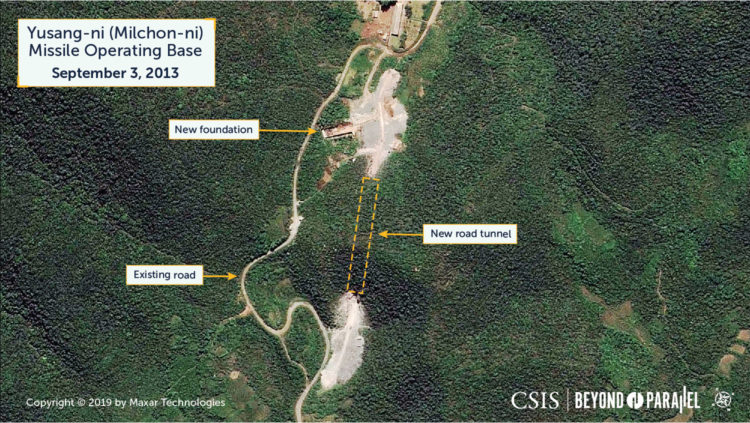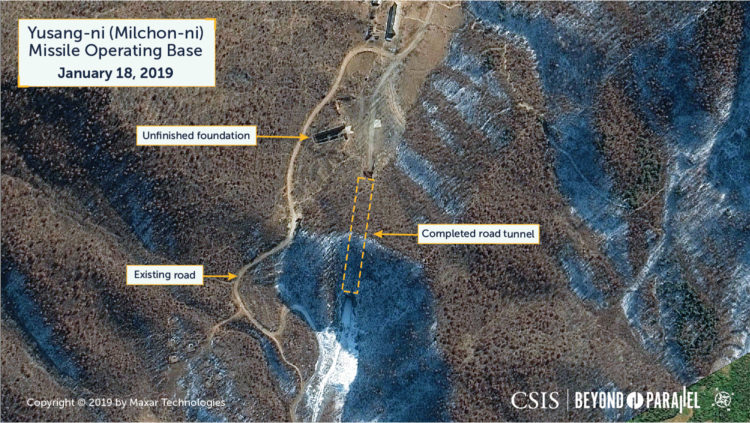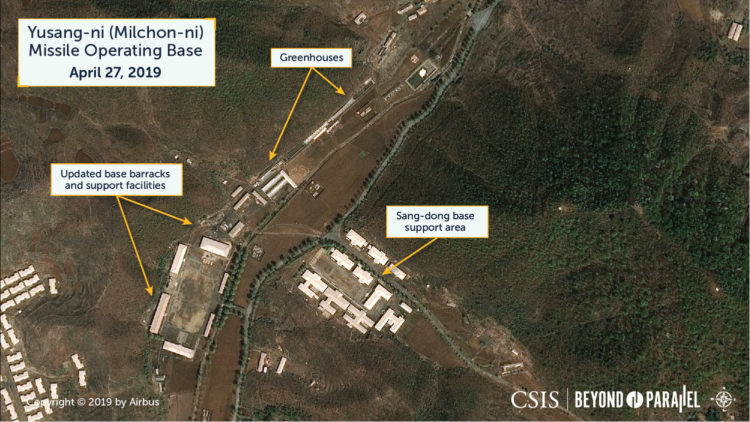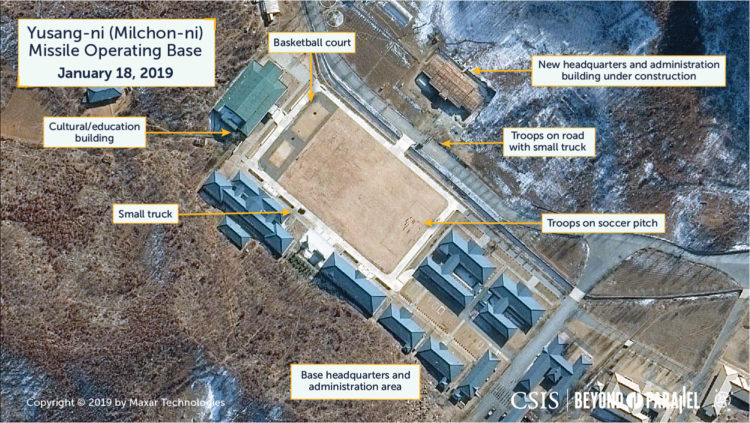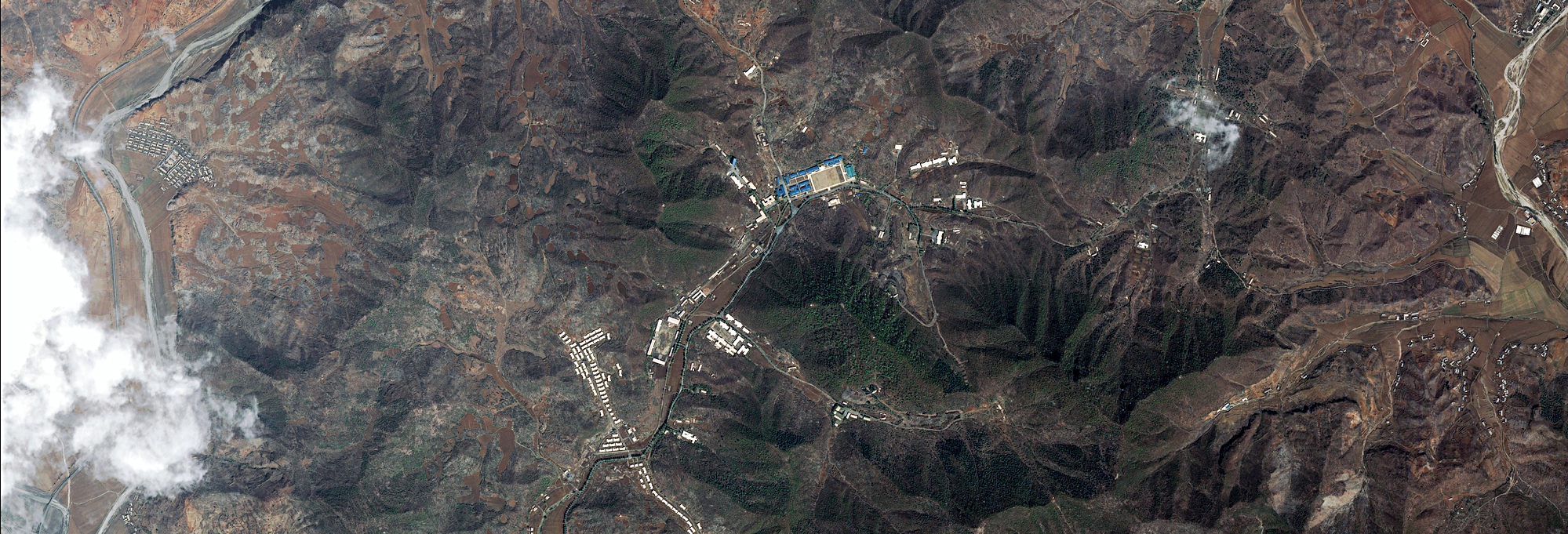
Undeclared North Korea: The Yusang-ni Missile Operating Base
Key Findings
- Located 150 kilometers north of the DMZ, the Yusang-ni missile operating base is an operational missile base that appears to house a unit of brigade-size or larger—likely with support units and is one of the more recently constructed Strategic Force missile operating bases.1
- There has been almost no open source information about this base until this study.
- Yusang-ni has been reported to house either the Hwasong-13 intercontinental ballistic missile (ICBM) that has not yet been tested, or the Hwasong-14 (tested on July 4 and July 28, 2017) or Hwasong-15 ICBMs (tested on November 29, 2017), but these reports must be viewed cautiously as production status is unknown.
- If these reports are true, however, Yusang-ni would represent an important undisclosed component of North Korea’s presumed offensive ballistic missile strategy by providing a strategic-level first strike capability against targets located throughout East Asia, the Pacific, and the continental United States.
- As of April 2019, satellite imagery shows the base is occupied, fully active, and being well-maintained by North Korean standards.
- The Yusang-ni missile operating base is one of approximately 20 North Korean ballistic missile operating bases and support facilities identified by CSIS analysis and never declared by North Korea.
- Given the threat posed by these bases, they would presumably have to be part of a final and fully verifiable denuclearization deal.
The Yusang-ni (유상리) missile operating base (39.449886 126.259682) is located within North Korea’s operational missile belt in Unsan-gun (Unsan County), Pyongan-namdo (South Pyongan Province) and sits 63 kilometers northeast of Pyongyang, 150 kilometers north of the demilitarized zone, 220 kilometers northeast of Seoul and 1,255 west-northwest of Tokyo. Disambiguation of references to reported missile bases or an ICBM base in Unsan-gun or the Sunchon area indicates that they are actually referring to the Yusang-ni missile operating base. This facility is sometimes referred to as the Milchon-ni (밀천리) missile operating base due to its proximity to the small village of that name (39.483333 126.233333) 4.5 kilometers to the north-northwest.
Subordinate to the Korean People’s Army (KPA) Strategic Force (the organization responsible for all North Korean ballistic missile units), the Yusang-ni missile operating base appears to house a unit of brigade-size or larger—likely with support units. What missile system(s) the unit at this base is equipped with is unclear. Reports from 2016 indicate that the base was equipped with a version of the Hwasong-13 (KN-08) intercontinental ballistic missile (ICBM).2 Subsequent reports from 2018 state that the unit was equipped with the Hwasong-14 (KN-20) or Hwasong-15 (KN-22) ICBMs.3 These reports should be viewed cautiously as the development and production status of these systems is unknown. Regardless, if ICBMs are based at the Yusang-ni missile operating base they would represent an important component of North Korea’s presumed offensive ballistic missile strategy by providing a strategic-level first strike capability against targets located throughout East Asia, the Pacific, and the continental United States. These systems undoubtedly represent crucial components of North Korea’s political bargaining strategy with the United States.
Development
Unlike many of North Korea’s other missile operating bases, almost no open source information concerning the development or operations of the Yusang-ni missile operating base is available. While the establishment of the base may have been a component of the original ballistic missile infrastructure development plan established during the late 1980s and early 1990s, it could equally have been a later logical expansion of the plan during the late 1990s as longer-range ballistic missiles became a technical reality. Regardless, it is unlikely that the engineering and construction resources required to build the base and the qualified personnel to operate the base were available prior to 2002 due to the establishment of other ballistic missile units, ballistic missile operating bases and related support facilities.
Analysis of Landsat commercial high-resolution satellite imagery indicates that construction of the Yusang-ni missile operating base likely began sometime between May and August 2003. The location selected for the base was the village of Yusang-ni, located 4.5 kilometers southeast of the small coal mining cities of Chae-dong (재동, 39.492503 126.203333) and Kubong-dong (구봉동, 39.481944 126.165556) 3.2 kilometers northeast of the village of Wonchang-ni (원창리, 39.4275, 126.234444) and 2.7 kilometers east of the Kichanghu-chon (기창후천, Kichanghu stream).
Prior to 2003, Yusang-ni was a small, rural agricultural village located in the mountainous central region of North Korea consisting of approximately 60 small housing and agricultural related structures of all types. With the construction of the Yusang-ni missile operating base, this would change dramatically. Satellite imagery indicates that while construction has proceeded steadily over the course of the past sixteen years, the majority of the essential infrastructure was completed by 2016. Some minor construction (e.g., of single buildings) is continuing as of April 2019. While it is uncertain, a significant portion of the construction is likely to have been undertaken by specialized engineering troops from the KPA’s Military Construction Bureau that had become available with the completion of work on other ballistic missile operating bases.
A satellite image from May 2002 shows the small agricultural village of Yusang-ni prior to any base construction-related activity. While subsequent Landsat imagery from 2003 indicates that construction of the Yusang-ni missile operating base had begun, it is of insufficient resolution to provide specific details. A high-resolution satellite image from September 3, 2004, however, shows considerable construction had already been accomplished and that it was ongoing. This construction work radiated out from Yusang-ni village and dispersed into the surrounding valleys. Most notable was the construction of two entrances (i.e., portals) to what appears to be a large underground facility (UGF) in the hill mass directly south of the village (subsequently to become the base headquarters area).


At present, construction appears to have continued in two slightly overlapping phases. The first phase from 2003-2011 focused on the UGF and general infrastructure development. The second phase from 2011-2018 focused upon the construction of actual missile base and support facilities.4 As of April 2019, satellite imagery shows the Yusang-ni missile operating base is occupied, active, and being well-maintained by North Korean standards.

The development of the Yusang-ni missile operating base can be functionally divided into six areas—headquarters and support area, underground facility, hardened drive-through missile support facility, Sangdong support area, Tapkol housing area and Kochon housing area.
Headquarters and Support Area: A September 2004 image shows that the roads leading to the village of Yusang-ni had been improved and approximately 125 small administration, support, and housing structures were added to the village itself and in the valleys to the northwest, north, and east. The vast majority of these new structures were for the construction personnel excavating the UGF and basic base infrastructure. With the exception of a number of small changes, the Yusang-ni area remained generally unchanged until 2011 when most of the remaining original village was razed and construction-related structures were relocated to temporary sites immediately to the north. These were slowly replaced during 2012-2017 by larger permanent missile base related headquarters, administration, barracks, agricultural support, and support structures. These were located throughout the immediate area and spread up the valleys to the northwest, north and east. While most of the headquarters and support area’s construction was completed during 2018, small changes have continued until present. For example, during early 2018 the worker compound immediately north of the headquarters area was razed and construction of a large building, immediately south of the headquarters area, has been undertaken during 2018-2019.


Work coinciding with the construction of the headquarters area began on a support area in the small valley immediately to the northwest of the headquarters area. Construction of 12 buildings was completed by 2011. Beginning during 2013, however, all but three of the existing buildings were razed and eight larger buildings were constructed in their place. The last of these was completed by January 2019. Notable was the construction, during 2013-2015, of a large four-story building with the entrance to a UGF across from it.
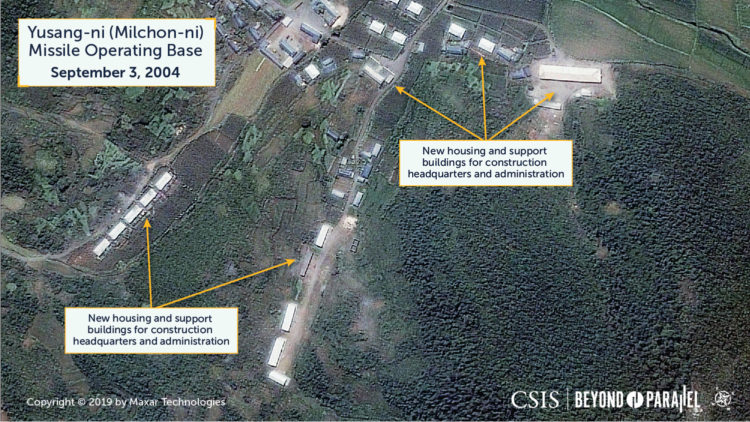
The support area in the valley northwest of the main headquarters area as seen a year-and-a-half after construction began, September 3, 2004 (Copyright © 2019 by Maxar Technologies) 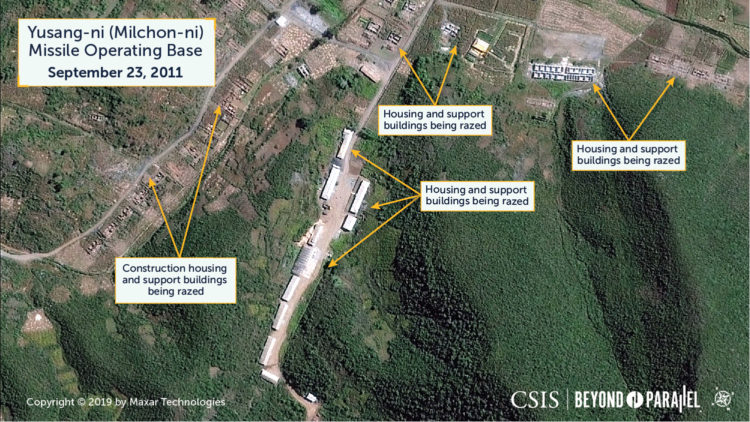
Additional construction housing and support buildings have replaced the remaining original agricultural buildings in the area, September 23, 2011 (Copyright © 2019 by Maxar Technologies) 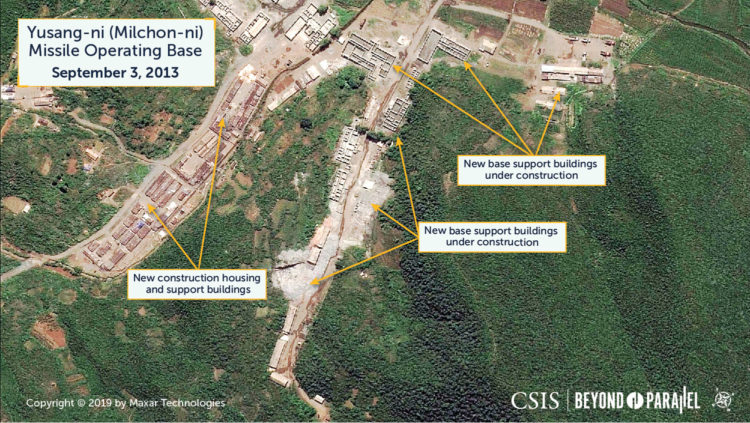
Most of the construction housing and support buildings have been razed and construction of larger permanent support buildings has begun, September 3, 2013 (Copyright © 2019 by Maxar Technologies) 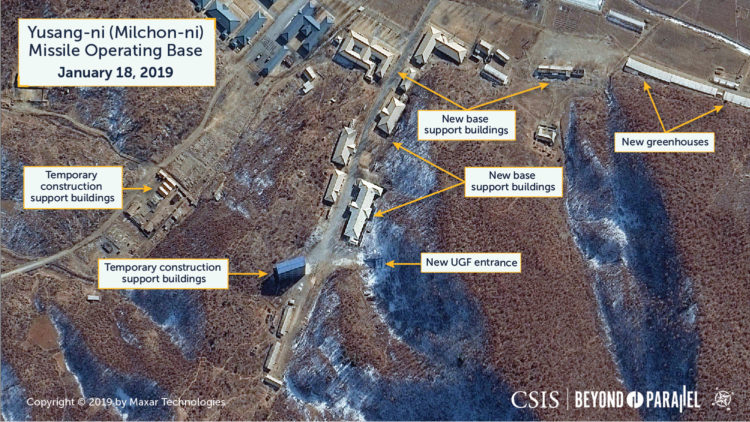
The permanent support buildings, including a four-story building, have been completed. A new UGF has also been excavated and its entrance is visible across from the four-story building, January 18, 2019 (Copyright © 2019 by Maxar Technologies)
In a separate valley, approximately 1,100 meters to the north of the headquarters area, construction of a road tunnel began during 2013. This was apparently undertaken to replace the existing narrow circuitous road with a straight road capable of permitting unhindered movement of large vehicles (TELs, MELs, etc.). Construction appears to have been completed by early 2018. During construction, a large excavation was dug outside the southern entrance to the tunnel that remains unfinished as of 2019.
By September 2004, new roads had been established in the valleys to the east of the headquarters area that connected a large number of small dispersed barracks and support facilities with over 100 small administration, support, and housing structures. Almost all of these new structures supported the construction personnel building the basic base infrastructure. With one notable exception, this area remained generally unchanged until 2011. The notable exception was the 2011 erection and subsequent removal of the framework for what appeared to be a four-story building in the support area 450 meters to the east of the headquarters area. Sometime during late-2011, most of the original structures in the valleys to the east of the headquarters area were razed and a construction project began to replace these with larger permanent barracks, agricultural support and support structures broadly grouped into six new barracks and support facilities. The majority of this work was completed in 2018.
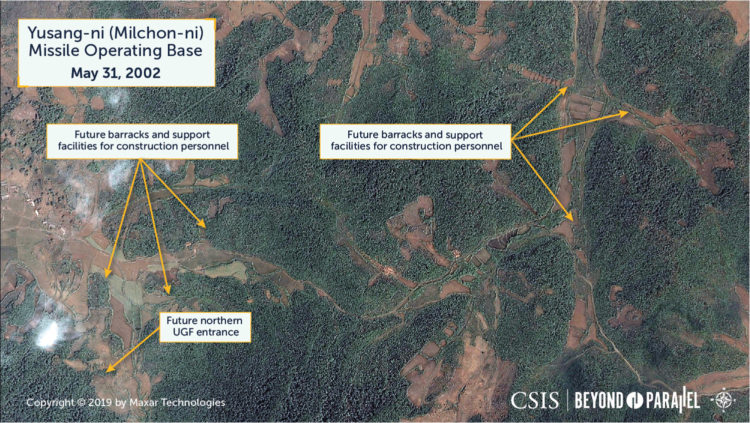
The area east of Yusang-ni village before construction began on the missile base, May 31, 2002 (Copyright © 2019 by Maxar Technologies) 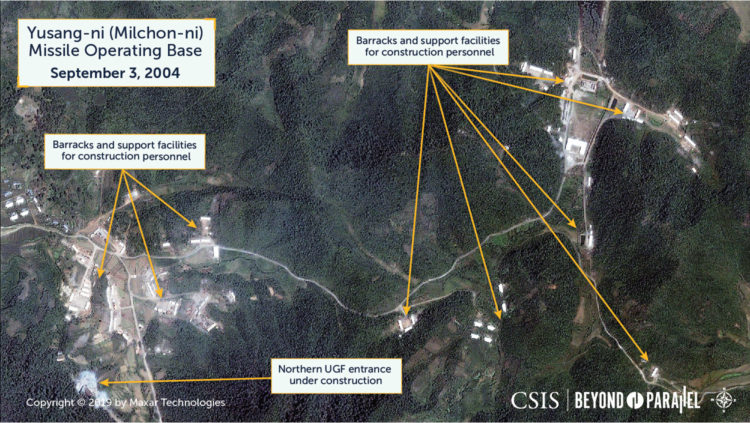
The construction and support areas east of the main headquarters a year-and-a-half after construction began, September 3, 2004 (Copyright © 2019 by Maxar Technologies) 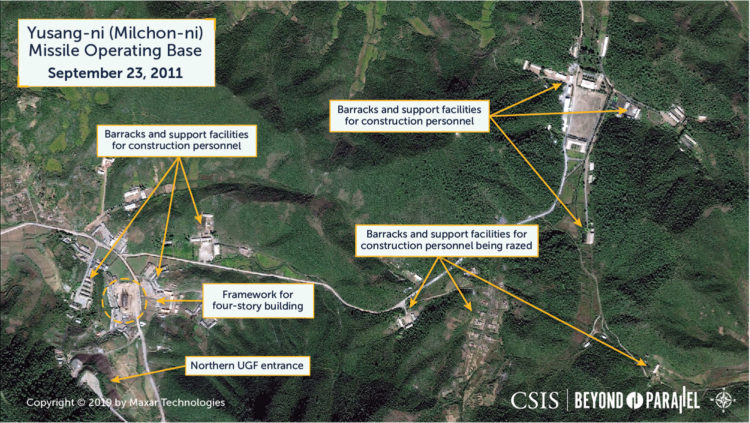
Construction and support buildings starting to be razed, September 23, 2011 (Copyright © 2019 by Maxar Technologies) 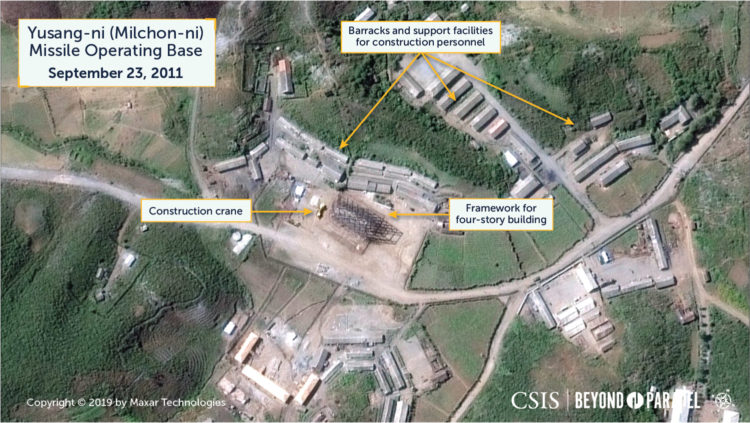
The framework for a four-story that was erected and then subsequently removed, September 23, 2011 (Copyright © 2019 by Maxar Technologies) 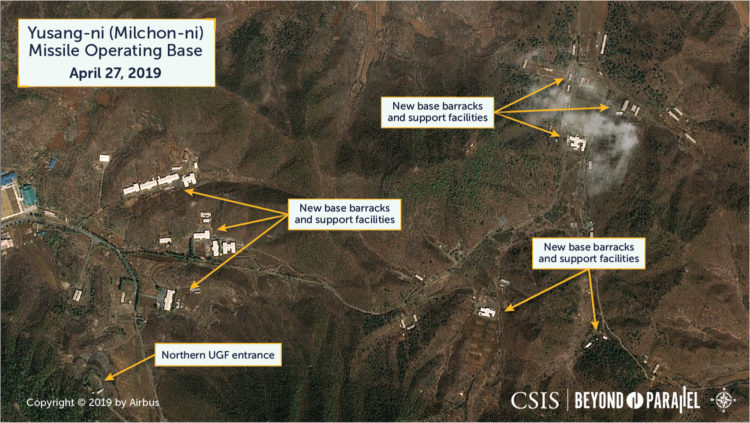
The new permanent barracks and support buildings have been completed, April 27, 2019 (Copyright © 2019 by Airbus)
Large Underground Facility: In the hill mass immediately south of the headquarters area, work on a large UGF began during 2003. A September 2004 image shows that roads had been built and construction was simultaneously underway on two UGF entrances on the opposite sides of the hill with large piles of spoil being deposited outside each entrance. Construction proceeded slowly and during construction, support at the entrances appears to have been relatively minimal with 3-4 small support buildings at each. Just south of the southern entrance, a small support compound with five buildings was also established. By November 2005, construction had begun on a large retaining wall outside the southern entrance. By September 2011, the majority of the work on both entrances was complete (including the retaining wall at the southern entrance). The small support buildings were razed, the ground backfilled at the southern entrance, the areas around both entrances landscaped with trees, and gravel laid on all access roads. The small support compound just south of the southern entrance was also razed, but was replaced by one with eight larger buildings. In an unusual development, sometime between September 2011 and September 2013, two buildings were erected directly on each of the access roads leading to both UGF entrances that from all appearances block vehicle access to the UGF (see below). Since that time both UGF entrances remain relatively unchanged and well maintained.


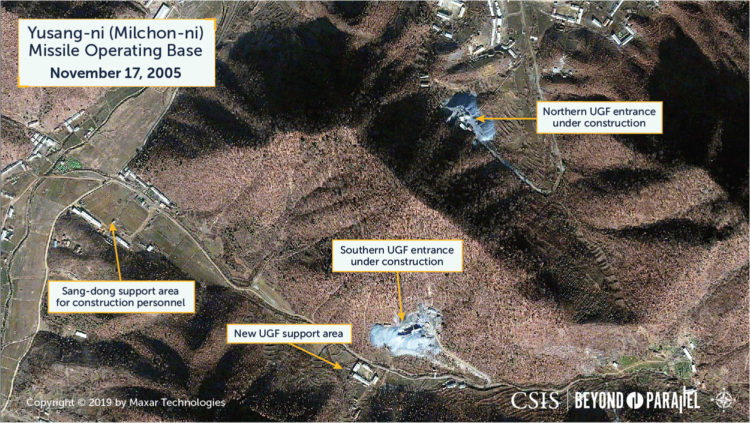
Hardened Drive-Through Missile Support Facility: During April 2008, excavation for what would become a two-bunker hardened drive-through missile support facility was observed approximately 250 meters to the east of the southern UGF entrance. By September 2011, the construction work was generally complete, bunkers covered, trees planted, and a gravel road had been extended to the southern UGF entrance. Subsequently, during 2015, some minor excavation was undertaken that added a small revetment on the south side of the open bay between the two bunkers. As with the UGF entrances, the drive-through facility remains relatively unchanged and well maintained since then.
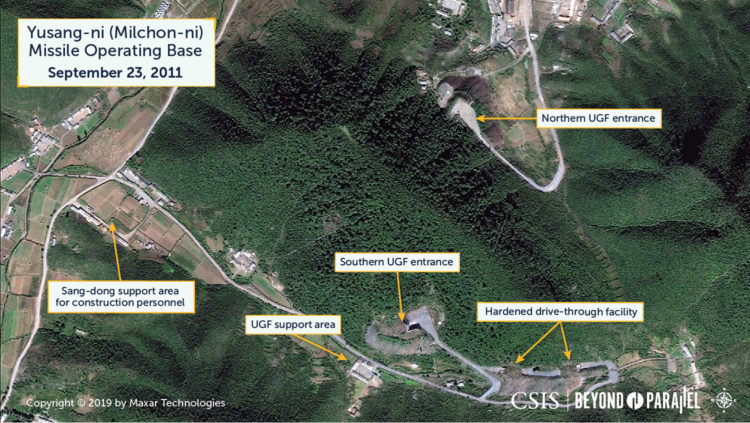


Sang-dong Support Area: Approximately 650 meters southwest of the headquarters area is the Sang-dong (상동 39.444985 126.254429) support area. Prior to 2004, this area consisted of small agricultural fields. By 2004, as part of the broader Yusang-ni missile operating base construction project, a support area was built consisting of approximately 60 housing, shop, agricultural support, maintenance, and warehouse structures of varying sizes. With the exception of the addition of approximately 12 new structures, the Sang-dong area remained relatively unchanged until September 2013 when all the existing structures were razed. These were replaced, during the next year-and-a-half, by seven large greenhouses and 27 barracks, housing, and support structures were built. This work would be essentially complete by 2015. With minor exceptions, the Sang-dong area has remained relatively unchanged since that time.
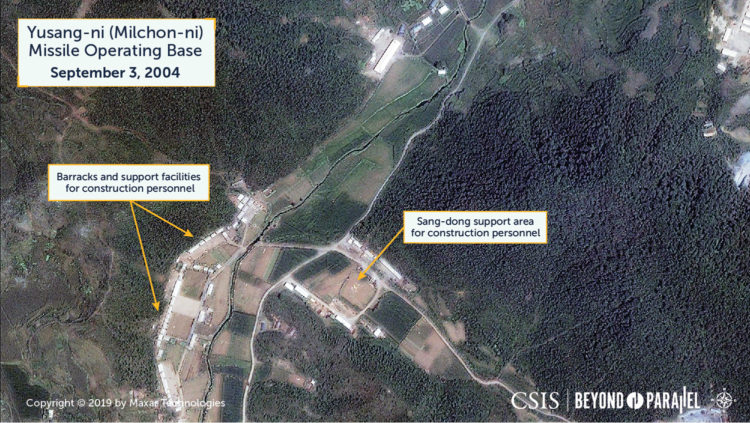
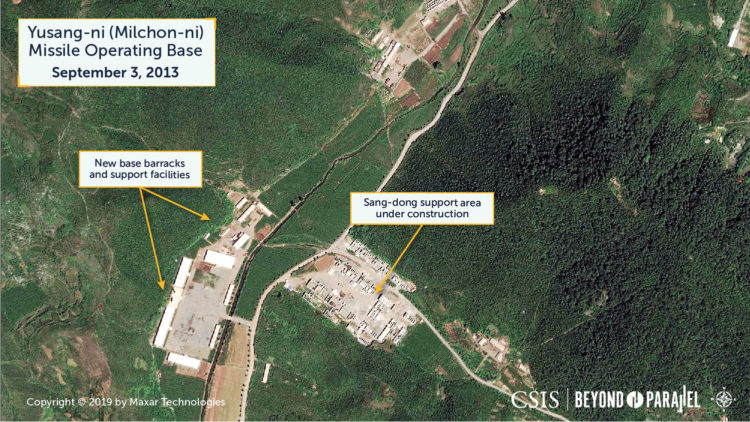
Tapkol Housing Area: Approximately 650 meters south of Sang-dong, and 1.3 kilometers south of the headquarters area, is the village of Tapkol (탑골, 39.439167, 126.251389). Prior to the establishment of the Yusang-ni missile operating base, Tapkol was a minor agricultural village with a small number of houses and agricultural buildings. By September 8, 2004, satellite imagery shows that a group of seven housing structures for construction workers had been built in a valley to the east side of the village. The following year, the number of housing structures had increased to 12. By 2011, the original village and some of the previously built housing structures in the valley to the east was razed and replaced by larger new housing and support structures. Three years later, during 2014, a second housing project began in the valley extending northwest of the village. This consisted of approximately 65 structures and was completed by late-2017. During 2015, a third housing project began in the small valley east of the village that was completed by 2017 with approximately 80 structures. As of January 2019, there are approximately 100 housing and support structures in the Tapkol area.
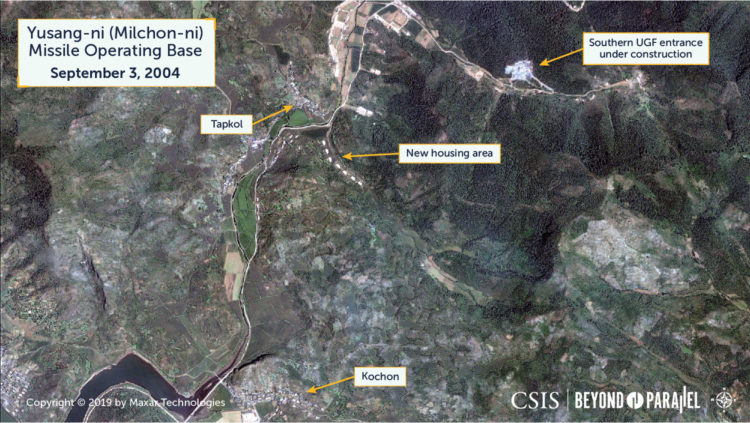
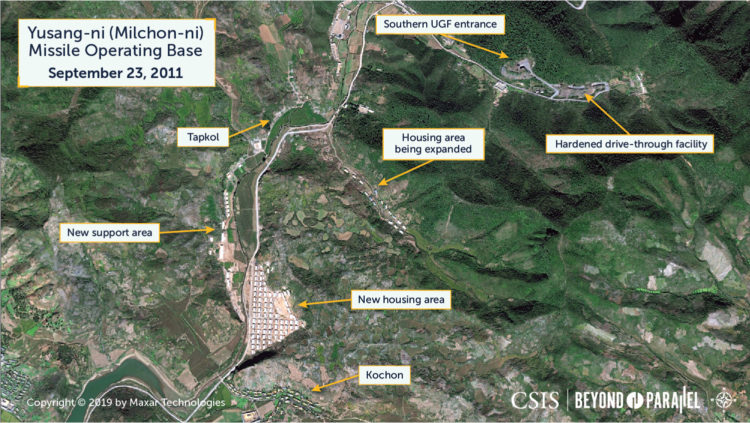
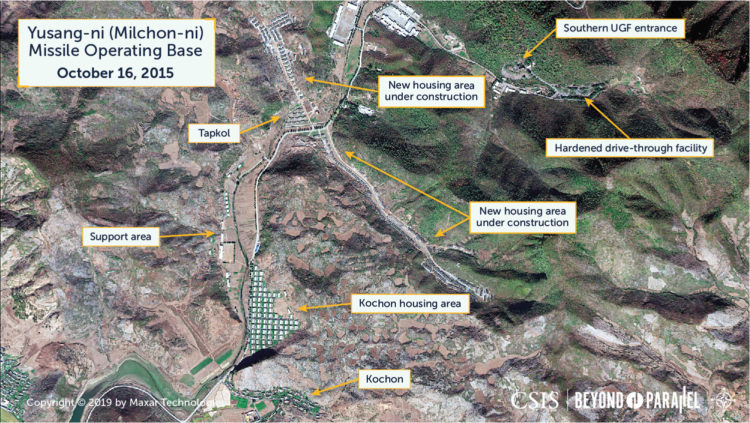
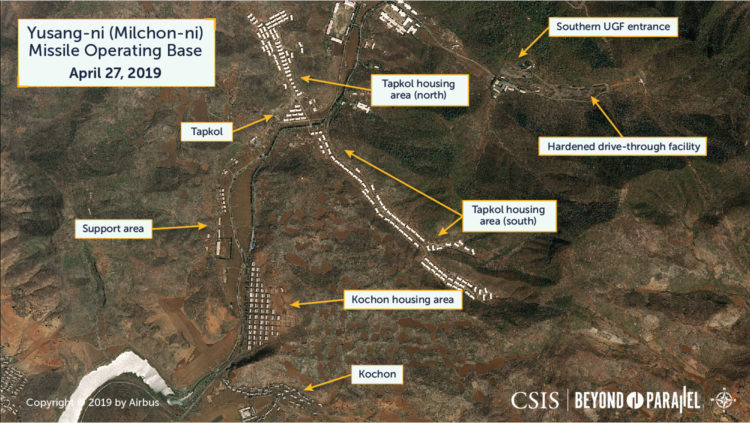
Kochon Housing Area: During 2011, another large housing project was undertaken immediately to the north of the village of Kochon, approximately 2.2 kilometers southwest of the headquarters area. This project witnessed the construction of approximately 90 housing related structures. This area has remained relatively unchanged since then.
Organization
The Yusang-ni missile operating base encompasses approximately 7.1 square kilometers and, as with many other Strategic Force missile operating bases, is centered on the intersection of the several valleys—in this case three primary valleys with several branch valleys.5 The primary valley runs southwest from the headquarters area at Yusang-ni for approximately four kilometers, through the small villages of Sang-dong (housing, support, and the southern entrance to the large UGF), Tapkol (housing), and Kochon (housing), to the Kichanghu-chon (Kichanghu stream). A secondary valley extends east from the headquarters area for approximately 2.4 kilometers servicing six dispersed barracks and support facilities and the northern entrance to the large UGF. The third and final valley runs north from the headquarters area through a newly constructed tunnel for approximately 2.9 kilometers to a rail station.
As noted above, the Yusang-ni missile operating base can be functionally divided into six areas—headquarters and support area, underground facility, drive-through facility, Sang-dong support area, Tapkol housing area, and Kochon housing area. However, the headquarters area, underground facility, and hardened drive-through facility are the most significant.
Within the headquarters and support area is the main headquarters consisting of nine large buildings (including headquarters and administration buildings, barracks and support buildings, a cultural/education hall completed in 2018, and a new building that began construction during 2018), a large parade ground (also used as a soccer pitch and other sports), and a large greenhouse.6 Located in the small branch valley extending northwest from the main headquarters area is a large four-story building and entrance to a UGF. This UGF is likely significantly smaller than the one immediately to the south of the headquarters judging from the smaller amount of spoil and an entrance that is approximately 6.5-meters-wide—still large enough to accommodate all presently known strategic Force ballistic missile equipment. Given its location and layout it would appear to be for storage or support equipment/vehicles. In the branch valley leading north is a road tunnel, approximately 1,100 meters the headquarters area, that was apparently built to permit unhindered movement of large vehicles (TELs, MELs, etc.). While entrances to UGFs are frequently found in tunnels within North Korea, it is unknown if there is one within this tunnel. A large excavation created during tunnel construction, is located adjacent to the southern entrance for unknown purposes. As of April 2019, it remains incomplete.
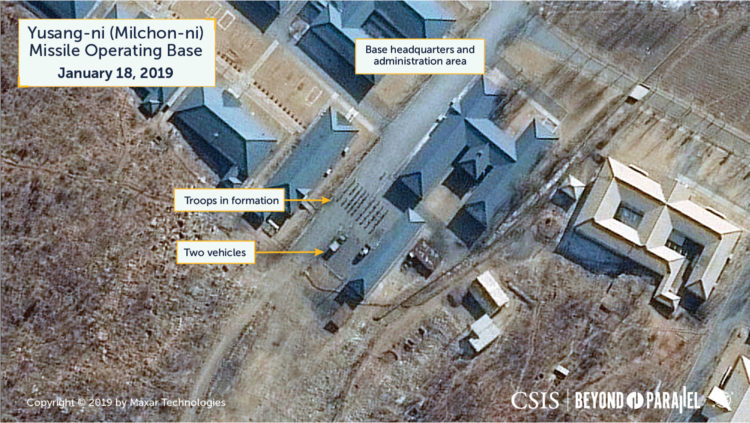
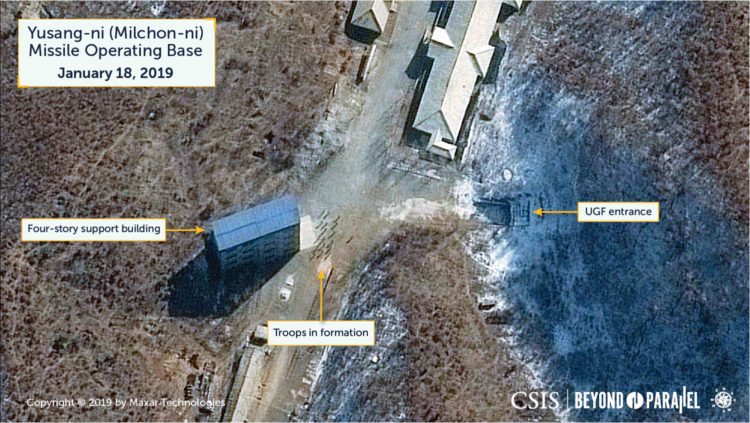
Located in the hill mass immediately south of the headquarters area is the base’s primary UGF with two entrances—one each on the north and south slopes of the ridgeline, approximately 400 meters apart. Their positioning and the amount of spoil produced during construction strongly suggests that this is a substantial UGF. Additionally, the presence of three small structures along ridgelines above the UGF, first observed during 2013, suggest that these cover air-handling shafts that would likely be required for a large UGF.7 The northern entrance is an approximately 9-meter-wide shaft, while the southern entrance initially appeared to consist of two shafts but eventually would be a single approximately 9-meter-wide shaft. Both entrances are large enough to accommodate all presently known Strategic Force ballistic missile equipment.8 As noted above, in one of the more curious developments at the Yusang-ni missile operating base sometime between September 2011 and September 2013, two buildings were erected directly on each of the access roads leading to both UGF entrances. From all appearances these block vehicle access to the UGF. Speculation concerning this development is ongoing; however, a detailed examination shows that the smaller of the two buildings—likely a shed—is relatively small (approximately 4-meters-by-4-meters and 5-meters-by-3.5-meters, respectively) and could be removed with little effort when required. This may lead to the assumption that their construction may be a rudimentary camouflage, concealment, and deception effort (CCD) by the Strategic Force.9 Regardless, the open area immediately outside the northern entrance and the protected area in front of the southern entrance are large enough accommodate all known Strategic Force TELs and MELs and permit missiles the launching of ballistic missiles.
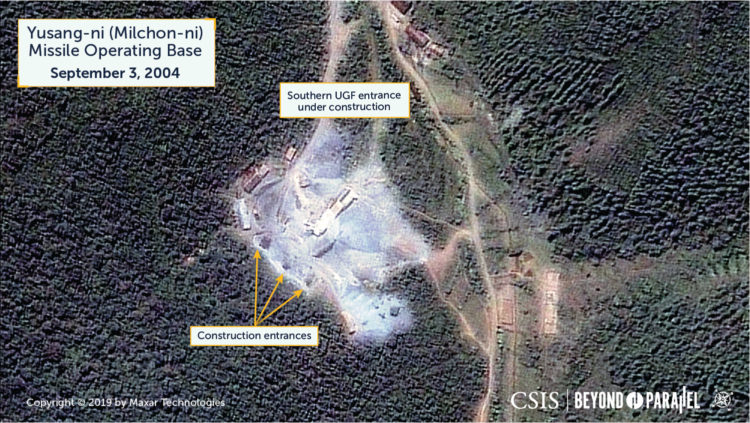
Close-up of the southern entrance to the large UGF under construction, September 3, 2004 (Copyright © 2019 Maxar Technologies) 
Close-up of the southern entrance to the large UGF under construction, November 17, 2005 (Copyright © 2019 Maxar Technologies) 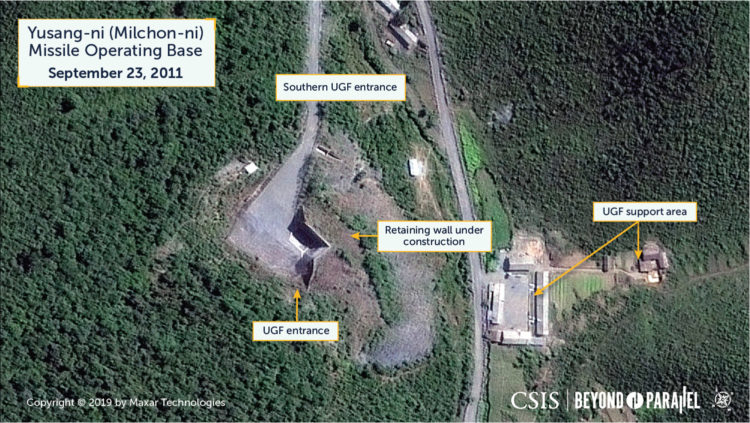
Close-up of the southern entrance to the large UGF under construction, September 23, 2011 (Copyright © 2019 Maxar Technologies) 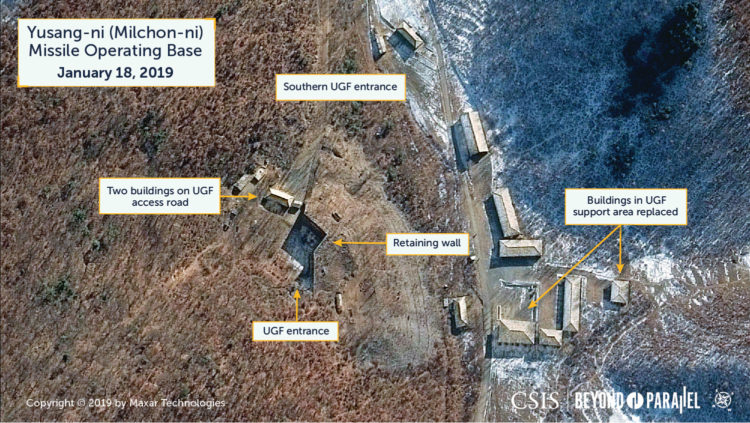
Close-up of the southern entrance to the large UGF after construction, January 18, 2019 (Copyright © 2019 Maxar Technologies)
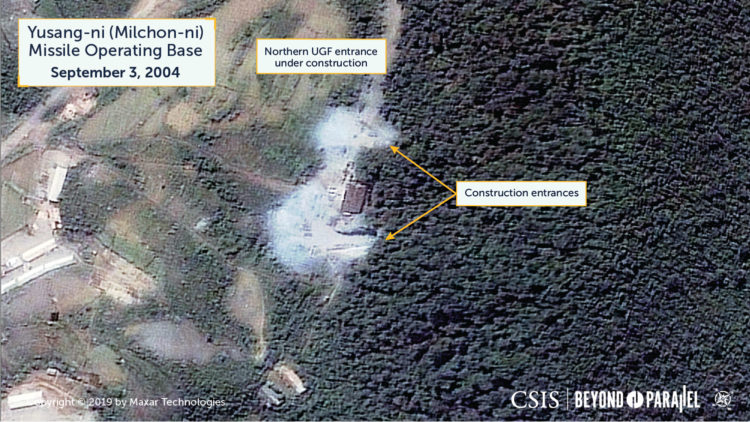
Close-up of the northern entrance to the large UGF under construction, September 3, 2004 (Copyright © 2019 Maxar Technologies) 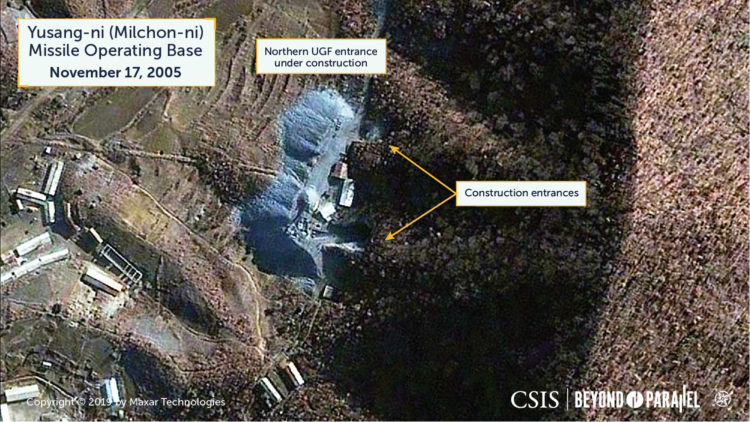
Close-up of the northern entrance to the large UGF under construction, November 17, 2005 (Copyright © 2019 Maxar Technologies 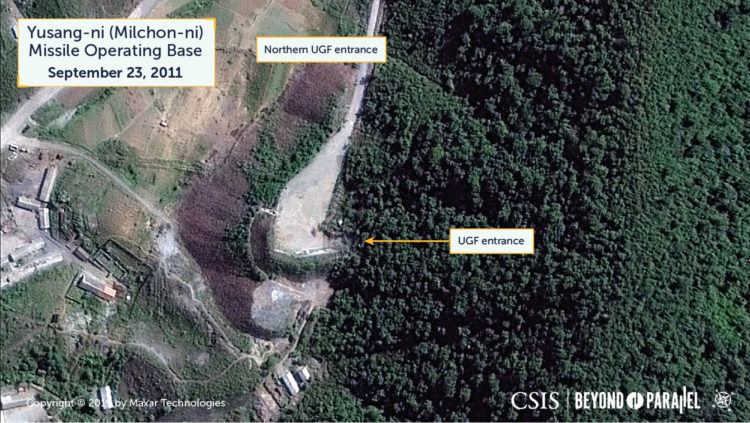
Close-up of the northern entrance to the large UGF under construction, September 23, 2011 (Copyright © 2019 Maxar Technologies) 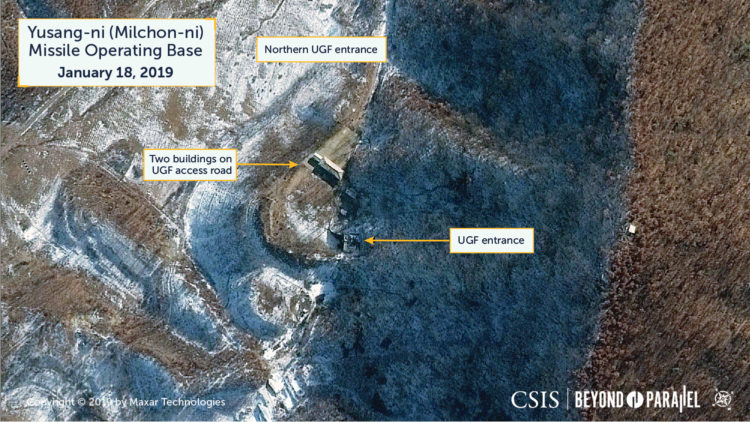
Close-up of the northern entrance to the large UGF after construction, January 18, 2019 (Copyright © 2019 Maxar Technologies)
Positioned immediately outside the southern UGF entrance and at the end of the 1-kilometer-long road extending east from the Sang-dong support area is a hardened drive-through missile support facility—used for arming, fueling, systems checkout, and maintenance operations. It measures approximately 180-meters-by-13-meters overall with two approximately 35-meter-long earth-covered shelters separated by an open bay. On the north side of the open bay is an approximately 5-meter opening that is likely an entrance to an underground storeroom or small UGF. On the south side of the open bay is a small, approximately 12-meter-by-7-meter revetment—likely for support vehicles or equipment.
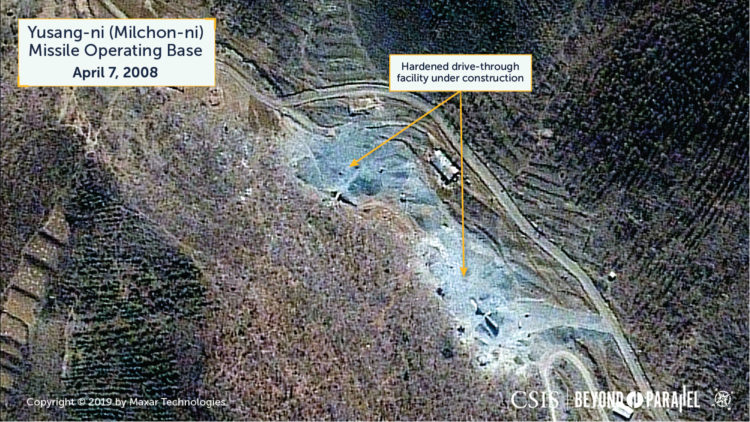
Close-up of the hardened drive-through facility, April 7, 2008 (Copyright © 2019 Maxar Technologies) 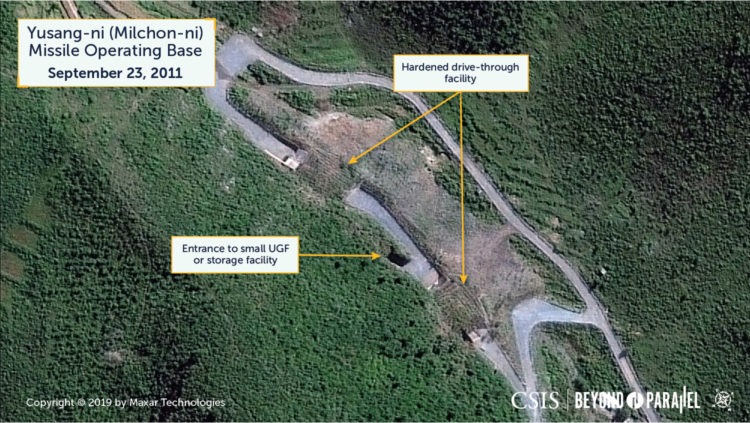
Close-up of the hardened drive-through facility after construction, September 23, 2011 (Copyright © 2019 Maxar Technologies) 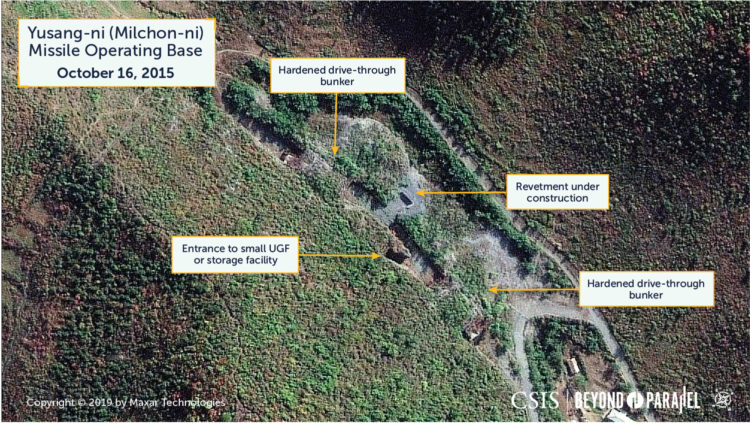
Close-up of the hardened drive-through facility showing the beginning of construction of a new revetment, October 16, 2015 (Copyright © 2019 Maxar Technologies) 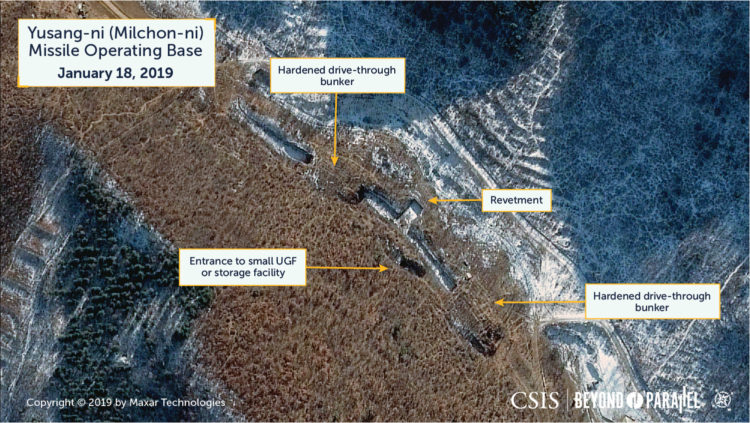
Recent close-up of the hardened drive-through facility, January 18, 2019 (Copyright © 2019 Maxar Technologies)
No detailed open source organizational information is available for the KPA ballistic missile unit at the Yusang-ni missile operating base, other than that it is part of the Strategic Force. Reports from 2016 state that the unit based here would be equipped with a version of the Hwasong-13 ICBM,10 while reports from 2018 state that the unit is equipped with the Hwasong-14 or Hwasong-15 ICBMs.11 All these reports should be viewed cautiously as the development and production status of these systems is unknown. From the nature, size, and distribution of the infrastructure (large number of housing units, number of barracks and support facilities, large and smaller UGFs, hardened drive-through facility, etc.) observed in satellite imagery it is likely it is a brigade- or larger-sized unit consisting of a headquarters, service and support elements, and several launch battalions.
Despite the strategic importance of all the KPA’s ballistic missile operating bases and concerns of either pre-emptive or wartime airstrikes against them, there are no known fixed anti-aircraft artillery positions within 10 kilometers of the base. It is likely that the missile unit based here possesses organic air defense elements equipped with both light AAA and shoulder-fired surface-to-air missiles (SA-7, SA-14, SA-16, etc.). The base, however, is within the air defense umbrella of three SA-2 and two SA-5 surface-to-air missile bases. Additionally, the Pukchang-ni Airbase (housing a MiG-23 air regiment) is only 28 kilometers to the northwest and the Sunchon (housing MiG-29 and Su-25 air regiments) Airbase is 31 kilometers to the west.12
Research Notes
This report, as are the others in this series, is based upon an ongoing study of the Korean People’s Army ballistic missile infrastructure begun by one of the authors, Joseph S. Bermudez Jr., in 1985. This study is based upon numerous interviews with North Korean defectors, government, defense, and intelligence officials around the world, as well as declassified documents and open source reporting. Accuracy in any discussion of North Korea’s nuclear, biological, chemical, or ballistic missile programs is always a challenge and while some of the information used in the preparation of this study may eventually prove to be incomplete, or incorrect, it is hoped that it provides a new and unique look into the subject. The information presented here supersedes or updates previous works by Joseph S. Bermudez Jr. on these subjects.
Although over 30 high-resolution and medium-resolution satellite images were analyzed during the preparation of this report, the images ultimately presented in this report were purposely selected for their detailed view of the structures and activities within and around the Yusang-ni missile operating base.
References
- The authors wish to thank Sang Jun Lee, research associate in the CSIS Korea Chair, Dana Kim and Andy Sau Ngai Lim, research assistants in the CSIS Korea Chair, and Young-Kyung Kim, intern in the CSIS Korea Chair, for their invaluable assistance in support of this project. ↩
- Author interview data; and Ahn Hyung-young. “North Korea is operating ICBM sites within four places such as Unpo-ri… ‘KN-08 already has been deployed’,” Chosun TV, October 24, 2016.
From the infrastructure observed in satellite imagery during 2015-2017 the Yusang-ni base had reached the point in 2016 where it was sufficiently developed to be able to house an operational ballistic missile unit.
There is considerable confusion concerning the domestic and foreign designations of North Korea’s ballistic missile systems in the open source literature. One of the more comprehensive reviews of these designations, and the one adhered to here, is Scott LaFoy, “The Hwasong that Never Ends,” Arms Control Wonk, August 28, 2017, http://www.armscontrolwonk.com/archive/1203797/the-hwasong-thatnever-ends/. ↩ - Ibid.; Jeon Kyoung-woong. “Let’s Pick Apart North Korean Tactics and Military Strength…North Korea’s Military,” FutureKorea, November 15, 2018. These reports should be viewed cautiously as the development and production status of these systems is unknown. ↩
- An argument could also be made for three overlapping construction phases: 2003-2011, 20112015 and 2015-2019. ↩
- Although undoubtedly associated with the Yusang-ni missile operating base the housing areas at Tapkol and Kochon may not be physically part of the base as there appears to be an entrance position and apparent guard barracks on the south side of the Sang-dong support area that may separate the base proper from these housing areas. ↩
- This greenhouse is one of many (large and small) distributed throughout the base. Greenhouses and agricultural support activities are not unusual within the Korean People’s Army as all units have a varying level of responsibility for growing their own food. ↩
- While these small structures could be guard positions there are no readily apparent trails leading to them as would be expected for such positions. ↩
- It is difficult to arrive at a precise measurement for the UGF entrances due to vegetation, shadow and the look angle and resolution of available imagery. These figures should, therefore be viewed with caution. ↩
- While a deception effort is the most likely reason at present for the positioning of these structures, at least two others are worth mentioning: 1) that while the base was designed and built as a ballistic missile operating base no missile unit has yet been deployed here due to limitations in missile production and trained personnel and 2) that before the completion of construction the decision was made to not base a missile unit here but instead use it to house a large infantry unit. ↩
- Author interview data; and Ahn Hyung-young. “North Korea is operating ICBM sites within four places such as Unpo-ri… ‘KN-08 already has been deployed’,” Chosun TV, October 24, 2016 ↩
- Ibid.; and Jeon Kyoung-woong. “Let’s Pick Apart North Korean Tactics and Military Strength…North Korea’s Military,” FutureKorea, November 15, 2018. ↩
- Bermudez Jr., Joseph S. Shield of the Great Leader: The Armed Forces of North Korea, (London: I.B. Taurus), 2001. ↩




